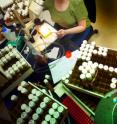Fruit fly helps identify protein critical to eggshell formation that may be pesticide target
The common fruit fly circling your week-old peach has helped scientists zero in on a protein critical to the insect's eggshell formation. The paradoxical finding gives scientists a better understanding of how the innermost protective eggshell layer forms as it points to a likely target for pesticide development, says Dr. Ellen LeMosy, developmental biologist in the Medical College of Georgia Schools of Medicine and Graduate Studies.
Her research team named the newly discovered protein palisade because knocking out the gene disrupted formation of a picket-fence-like line up of protein balls called vitelline bodies. Within 18 to 24 hours, the bodies should meld into a solid, transparent membrane that is the egg's first line of defense.
"You can take the outer layer of the eggshell off. With bleach, it dissolves and it just leaves this inner vitelline membrane and that is sufficient to maintain the structure," she says. "If the egg does not have external support, it would pop like a balloon. It's very soft." The membrane also helps keep the egg from drying out.
Without palisade, a key protein of the shell's membrane also gets taken up in the egg. "Think of the vitelline membrane as made up of four colors of brick and one of the colors falls into the oocyte. We don't know if there is any direct consequence of having that brick taken up by the oocyte: it could be just trash. But not having it in the eggshell means the vitelline membrane won't form properly, so the egg won't survive anyway," Dr. LeMosy says.
Palisade could prove a great target for pesticides, which today are largely neurotoxins, because humans don't have it, says Dr. LeMosy, corresponding author on the study published online in Developmental Biology. She notes that "good" insects, such as ladybugs and praying mantis that have a big appetite for other insects, could be potential casualties.
Her studies, which include the form and function of fingerlike microvilli – found in the ears, gastrointestinal tract and reproductive system – led her to palisade. During usual eggshell formation, vitelline bodies are sandwiched between these microvilli fingers. Microvilli fingers and vitelline bodies are fairly uniform in size, shape, spacing and orientation. Remove palisade, and you get microvilli of different lengths pointing in different directions surrounding odd-sized, irregularly spaced protein balls.
"We don’t exactly know what they are doing with the vitelline bodies," Dr. LeMosy says of microvilli. "What we think is going on is the microvilli are making a scaffold, like a framework for a house." At the right time, microvilli back out so the vitelline bodies can merge into a membrane. Now she wants to know how the scaffold works.
"Is it a physical scaffold or some sort of biochemical connection where you have to have certain molecules touching in order to get the eggshell? You can't use this as a target for pesticides if you don't know how the process works." Her studies also include a protein called Cad99C in fruit flies and PCDH15 in humans, which also appears important to normal formation of microvilli and vitelline membrane.
"From a basic science point of view, it's a model for matrix assembly," Dr. LeMosy says. In the case of PCDH15 at least, problems with this protein can result in malformed microvilli and deafness in humans. She believes the vitelline membrane also has a role in embryonic patterning, which is essentially how the embryo learns which way is up.
"Eggs and shells form about the same time," she says. The vitelline bodies may need to be separate during that time to allow flexibility for the egg to grow, and even after the membrane is formed a little growing occurs. During formation, two holes are left in the shell. One lets sperm in for fertilization. Twenty-four hours later, the embryo spits digestive juices out of the other hole so the egg shell will dissolve and the maggot will emerge.
Source: Medical College of Georgia
Other sources
- Fruit fly helps identify protein critical to eggshell formation that may be pesticide targetfrom Biology News NetThu, 29 May 2008, 21:35:34 UTC
- Fruit Fly Helps Identify Protein Critical to Eggshell Formation That May be Pesticide Targetfrom PhysorgThu, 29 May 2008, 15:35:32 UTC
